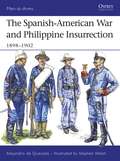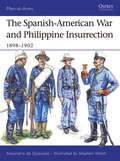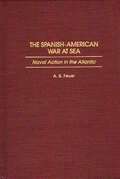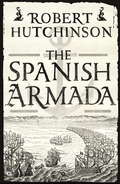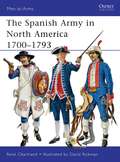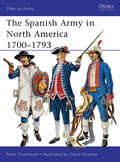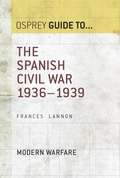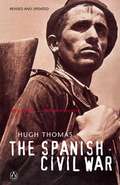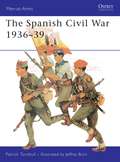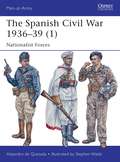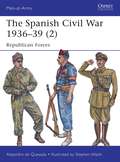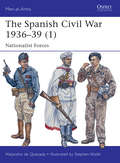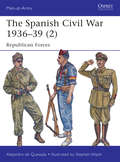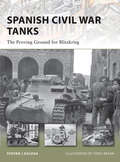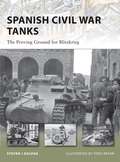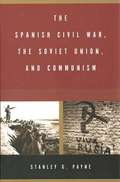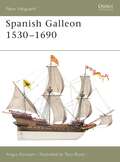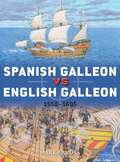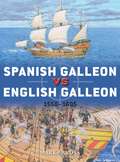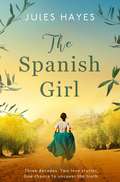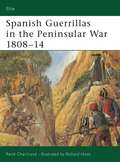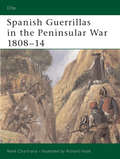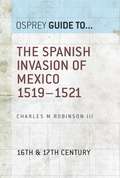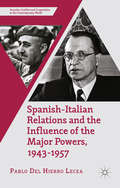- Table View
- List View
The Spanish-American War and Philippine Insurrection: 1898–1902 (Men-at-Arms)
by Stephen Walsh Alejandro De QuesadaThis book details the uniforms and weapons of the American, Spanish, Cuban and Filipino forces involved in the United States Army's first overseas war. In 1898 the USA took the decision to intervene in the Cuban war of independence against Spain, and to expel the last vestige of European colonial rule from the Americas. This also led to the US acquiring rule over the Philippine Islands; and there, US troops were sent into the jungle to fight a "colonial†? war of their own, against Filipino insurgents unwilling to exchange one master for another. The text is illustrated with rare early photographs and color plates.
The Spanish-American War and Philippine Insurrection: 1898–1902 (Men-at-Arms #437)
by Stephen Walsh Alejandro De QuesadaThis book details the uniforms and weapons of the American, Spanish, Cuban and Filipino forces involved in the United States Army's first overseas war. In 1898 the USA took the decision to intervene in the Cuban war of independence against Spain, and to expel the last vestige of European colonial rule from the Americas. This also led to the US acquiring rule over the Philippine Islands; and there, US troops were sent into the jungle to fight a "colonial†? war of their own, against Filipino insurgents unwilling to exchange one master for another. The text is illustrated with rare early photographs and color plates.
The Spanish-American War at Sea: Naval Action in the Atlantic (Non-ser.)
by A. B. FeuerBy piecing together diaries, letters, scrapbooks, and rare privately printed memoirs, the author has created a story which tells how America's ragtag navy—composed mainly of converted yachts, steamers and tugboats—was able to fight and win against the more powerful Spanish gunboats. The naval battles fought in places like Santiago, Cardenas, Cienfuegos, Manzanillo, Port Nipe, Guantanamo, San Juan, Guanica, and Ponce come alive in this book. The stories of the brave little ships that fought these battles—with names like the Gloucester and the Yosemite—at times against overwhelming odds, demonstrates the excellent training of the men who manned their guns under leadership of daring officers. This book fills in many of the missing pieces in the history of the Spanish-American War.
The Spanish Armada: A History
by Robert HutchinsonA dramatic blow-by-blow account of the defeat of the Spanish Armada by the English fleet - a tale of derring-do and disaster on the high seas by one of our best narrative historians.After the accession of Elizabeth I in 1558, Protestant England was beset by the hostile Catholic powers of Europe - not least Spain. In October 1585 King Philip II of Spain declared his intention to destroy Protestant England and began preparing invasion plans, leading to an intense intelligence war between the two countries, culminating in the dramatic sea battles of 1588.Robert Hutchinson's tautly written book is the first to examine this battle for intelligence, and uses everything from contemporary eye-witness accounts to papers held by the national archives in Spain and the UK to recount the dramatic battle that raged up the English Channel. Contrary to popular theory, the Armada was not defeated by superior English forces - in fact, Elizabeth I's parsimony meant that her ships had no munitions left by the time the Armada had fought its way up to the south coast of England. In reality it was a combination of inclement weather and bad luck that landed the killer blow on the Spanish forces, and of the 125 Spanish ships that set sail against England, only 60 limped home - the rest sunk or wrecked with barely a shot fired.
The Spanish Army in North America 1700–1793 (Men-at-Arms)
by David Rickman René ChartrandLong before England established a serious presence in the New World, Spain had already established an overseas Empire. In North America, this included vast tracts of territory including most of what today comprises the states of Florida, Arizona, Nevada, New Mexico, Texas, Alabama, Illinois and California. In later years, as the British and the French came to expand their claims, they often came into conflict with the Spanish. The Spanish also played a significant part during the American Revolution, fighting against the British and drawing off forces needed to fight the Americans. This book covers all of the North American Spanish forces that fought in the campaigns of the 18th century.
The Spanish Army in North America 1700–1793 (Men-at-Arms #475)
by David Rickman René ChartrandLong before England established a serious presence in the New World, Spain had already established an overseas Empire. In North America, this included vast tracts of territory including most of what today comprises the states of Florida, Arizona, Nevada, New Mexico, Texas, Alabama, Illinois and California. In later years, as the British and the French came to expand their claims, they often came into conflict with the Spanish. The Spanish also played a significant part during the American Revolution, fighting against the British and drawing off forces needed to fight the Americans. This book covers all of the North American Spanish forces that fought in the campaigns of the 18th century.
The Spanish Civil War: 1936–1939 (Guide to...)
by Frances LannonThe Spanish Civil War of 1936-39 was of enormous international as well as national significance. In this gripping volume, Frances Lannon explains how this internal conflict between democracy and its enemies escalated to involve Nazi Germany, Fascist Italy, and the Soviet Union. We go behind the scenes to find out the true story of the bitter fighting within the sides, not just between them. The experiences of the men and women caught up in the fighting are highlighted. For them, and for a world on the brink of the Second World War, the stakes were agonisingly high.
The Spanish Civil War: An Eyewitness Account Of The Spanish Civil War (Pelican Ser.)
by Hugh ThomasThough more than half a century has passed since the Spaish Civil War began in 1936, it is still the subject of intense controversy. What was it that roused left wing sympathisers from all over the world to fight for a cause for which their governments would not give active support? In his famous history, Hugh Thomas presents an objective analysis of a conflict - where fascism and democracy, communism and Christianity, centralism and regionalism were all at stake - and which was a much an international civil war as a Spanish one.
The Spanish Civil War 1936–39 (Men-at-Arms #74)
by Jeffrey Burn Patrick TurnbullBy the spring of 1936 an armed clash was imminent between the forces of Spain's extreme Left and extreme Right. Viewed largely as a confrontation between democracy and fascism, the resulting civil war proved to be of enormous international significance. Nazi Germany and Fascist Italy intervened to assist General Franco, while the Soviet Union came to the aid of the Republican forces. This book explains the background to the war and charts the course of the nearly three-year long conflict through to General Franco's victory. Photographs and colour plates illustrate the uniforms and equipment of the Republican and Nationalist armies.
The Spanish Civil War 1936–39 (Men-at-Arms #74)
by Patrick TurnbullBy the spring of 1936 an armed clash was imminent between the forces of Spain's extreme Left and extreme Right. Viewed largely as a confrontation between democracy and fascism, the resulting civil war proved to be of enormous international significance. Nazi Germany and Fascist Italy intervened to assist General Franco, while the Soviet Union came to the aid of the Republican forces. This book explains the background to the war and charts the course of the nearly three-year long conflict through to General Franco's victory. Photographs and colour plates illustrate the uniforms and equipment of the Republican and Nationalist armies.
The Spanish Civil War 1936–39: Nationalist Forces (Men-at-Arms)
by Stephen Walsh Alejandro De QuesadaThe Spanish Civil War, 1936–39, was the curtain-raiser to World War II, and the major international event of the 1930s. It was the first great clash of 20th-century ideologies, between the rebel Nationalist army led by General Franco (right-wing, and aided by Nazi Germany and Fascist Italy), and the Republican army of the government (left-wing, and aided by the Communist Soviet Union and many volunteers from liberal democracies). Three years of widespread campaigns involved the most modern weapons available. The war was fought ruthlessly by both sides, and when the Nationalists secured victory they installed a dictatorship that lasted until November 1975 – the last such regime in Western Europe. Featuring specially commissioned full-color artwork, this first part of a two-part study depicts the fighting men of the Nationalist forces that strove to take control of Spain alongside their German and Italian allies.
The Spanish Civil War 1936–39: Republican Forces (Men-at-Arms #498)
by Stephen Walsh Alejandro De QuesadaThe Spanish Civil War was the curtainraiser to World War II and involved a complex collection of forces, particularly on the Republican side. This title illustrates how diverse the Republican forces were, drawn from loyal elements of the Spanish army that rejected the appeal of the rebel generals, a wide range of volunteer regional units and political militias, and supported by volunteers from many other countries, including Great Britain, France and Germany, in units known as the International Brigades. The wide range of equipment and uniforms worn by these troops is revealed, as is, the organization of militias into conventional brigades and divisions. Featuring specially commissioned full-colour artwork, this second part of a two-part study depicts the fighting men of the Republican forces and examples of their foreign comrades.
The Spanish Civil War 1936–39: Nationalist Forces (Men-at-Arms #495)
by Stephen Walsh Alejandro De QuesadaThe Spanish Civil War, 1936–39, was the curtain-raiser to World War II, and the major international event of the 1930s. It was the first great clash of 20th-century ideologies, between the rebel Nationalist army led by General Franco (right-wing, and aided by Nazi Germany and Fascist Italy), and the Republican army of the government (left-wing, and aided by the Communist Soviet Union and many volunteers from liberal democracies). Three years of widespread campaigns involved the most modern weapons available. The war was fought ruthlessly by both sides, and when the Nationalists secured victory they installed a dictatorship that lasted until November 1975 – the last such regime in Western Europe. Featuring specially commissioned full-color artwork, this first part of a two-part study depicts the fighting men of the Nationalist forces that strove to take control of Spain alongside their German and Italian allies.
The Spanish Civil War 1936–39: Republican Forces (Men-at-Arms #498)
by Stephen Walsh Alejandro De QuesadaThe Spanish Civil War was the curtainraiser to World War II and involved a complex collection of forces, particularly on the Republican side. This title illustrates how diverse the Republican forces were, drawn from loyal elements of the Spanish army that rejected the appeal of the rebel generals, a wide range of volunteer regional units and political militias, and supported by volunteers from many other countries, including Great Britain, France and Germany, in units known as the International Brigades. The wide range of equipment and uniforms worn by these troops is revealed, as is, the organization of militias into conventional brigades and divisions. Featuring specially commissioned full-colour artwork, this second part of a two-part study depicts the fighting men of the Republican forces and examples of their foreign comrades.
Spanish Civil War Tanks: The Proving Ground for Blitzkrieg (New Vanguard #170)
by Steven J. ZalogaThe tanks used during the Spanish Civil War are not often examined in any great detail, and are often labeled as little more than test vehicles in a convenient proving ground before World War II. But, with groundbreaking research, armor expert Steven J Zaloga has taken a fresh look at the tanks deployed in Spain, examining how future tanks and armored tactics were shaped and honed by the crews' experiences, and how Germany was able to benefit from these lessons while their Soviet opponents were not. Based on recently uncovered records of Soviet tankers in Spain and rare archival accounts, this book describes the various tanks deployed in Spain, including the PzKpfw I and the T-26.
Spanish Civil War Tanks: The Proving Ground for Blitzkrieg (New Vanguard)
by Steven J. Zaloga Tony BryanThe tanks used during the Spanish Civil War are not often examined in any great detail, and are often labeled as little more than test vehicles in a convenient proving ground before World War II. But, with groundbreaking research, armor expert Steven J Zaloga has taken a fresh look at the tanks deployed in Spain, examining how future tanks and armored tactics were shaped and honed by the crews' experiences, and how Germany was able to benefit from these lessons while their Soviet opponents were not. Based on recently uncovered records of Soviet tankers in Spain and rare archival accounts, this book describes the various tanks deployed in Spain, including the PzKpfw I and the T-26.
The Spanish Civil War, the Soviet Union, and Communism (PDF)
by Stanley PayneIn this compelling book Stanley Payne offers the first comprehensive narrative of Soviet and Communist intervention in the revolution and civil war in Spain. He documents in unprecedented detail Soviet strategies, Comintern activities, and the role of the Communist party in Spain from the early 1930s to the end of the civil war in 1939. Drawing on a very broad range of Soviet and Spanish primary sources, including many only recently available, Payne changes our understanding of Soviet and Communist intentions in Spain, of Stalin's decision to intervene in the Spanish war, of the widely accepted characterisation of the conflict as the struggle of fascism against democracy, and of the claim that Spain's war constituted the opening round of World War II. The author arrives at a new view of the Spanish Civil War and concludes not only that the Democratic Republic had many undemocratic components but also that the position of the Communist party was by no means counterrevolutionary.
Spanish Galleon 1530–1690 (New Vanguard)
by Angus KonstamDuring the middle decade of the 16th century a new type of sailing vessel emerged, designed to carry the wealth of the Americas to Spain. This was the galleon, and over the next century these vessels would serve Spain well as treasure ships and warships, becoming a symbol of Spanish power and wealth during the period. The development and construction of the Spanish galleon are discussed in this book, and the ordnance and crewing needed to produce and maintain these stately vessels is covered. The author also examines the role of the galleon as a treasure ship, and describes how these ships were manned and fought in action.
Spanish Galleon vs English Galleon: 1550–1605 (Duel)
by Mark LardasBetween 1550–1600, Europe witnessed a rapid evolution in the art of ship design which enabled safer and more efficient transatlantic travel. This was the pinnacle of the Age of Discovery and Exploration for the European powers, in which the galleon played a crucial role. Galleons were both the main vessels in maritime commerce and the principal warships used by the opposing fleets throughout the Age of Exploration. This period also saw a large amount of naval combat, much of it between individual ships belonging to the competing powers of England and Spain as they sought to control and exploit the rich mineral, material, agricultural and human resources of the New World. The conflict between the English Sea Dogs and the Spanish Adventurers has been a source of fascination for over four centuries. This exciting addition to the Duel series explores how the galleons used by Spain and England were built and armed, and examines the effectiveness of the cannon they used. It also compares how they were sailed and manoeuvred, showing the strengths and weaknesses of each design, and explaining how these played out in several of their most prominent battles, including the Battle of San Juan de Ulúa, the fight between the Golden Hind and the Nuestra Señora de la Concepción, an action from the Spanish Armada, and the last fight of the Revenge.
Spanish Galleon vs English Galleon: 1550–1605 (Duel #106)
by Mark LardasBetween 1550–1600, Europe witnessed a rapid evolution in the art of ship design which enabled safer and more efficient transatlantic travel. This was the pinnacle of the Age of Discovery and Exploration for the European powers, in which the galleon played a crucial role. Galleons were both the main vessels in maritime commerce and the principal warships used by the opposing fleets throughout the Age of Exploration. This period also saw a large amount of naval combat, much of it between individual ships belonging to the competing powers of England and Spain as they sought to control and exploit the rich mineral, material, agricultural and human resources of the New World. The conflict between the English Sea Dogs and the Spanish Adventurers has been a source of fascination for over four centuries. This exciting addition to the Duel series explores how the galleons used by Spain and England were built and armed, and examines the effectiveness of the cannon they used. It also compares how they were sailed and manoeuvred, showing the strengths and weaknesses of each design, and explaining how these played out in several of their most prominent battles, including the Battle of San Juan de Ulúa, the fight between the Golden Hind and the Nuestra Señora de la Concepción, an action from the Spanish Armada, and the last fight of the Revenge.
The Spanish Girl: A completely gripping and heartbreaking historical novel
by Jules Hayes'A splendid story of heartbreaking consequences and ambition during the Spanish Civil War... A recommended read' Glynis Peters, bestselling author of The Secret Orphan***A country torn apart by war.Two love stories divided by decades.One chance to discover the truth... Feisty journalist Isabella has never known the truth about her family. Escaping from a dangerous assignment in the turbulent Basque country, she finds her world turned upside down, firstly by her irresistible attraction to the mysterious Rafael, and then by a new clue to her own past. As she begins to unravel the tangled story of her identity, Isabella uncovers a story of passion, betrayal and loss that reaches back to the dark days of Spain's civil war - when a passionate Spanish girl risked everything for her country, and for the young British rebel who captured her heart. But can Isabella trust the man she's fallen in love with? Or are some wartime secrets better left undisturbed...? Heartbreaking, gripping historical fiction about the tragedy of war, and the redemption of love. Perfect for fans of Angela Petch's The Tuscan Secret and Kathryn Hughes' The Letter. ***Praise for The Spanish Girl:'An outstanding read... Epic, personal, intimate and beautifully written' Lizzie Page, author of The Forgotten Girls'A compelling tale of friendship, love and loss. Impeccably researched, the story is full of surprises' Rhiannon Ward, author of The Quickening'A fabulous read of love, loss, loyalty and bravery set against the fascinating backdrop of the Spanish War. I was engrossed from the start and a must read for fans of dual timeline women's fiction' Suzanne Fortin, author of The Forgotten Life of Arthur Pettinger
Spanish Guerrillas in the Peninsular War 1808–14 (Elite)
by Richard Hook René ChartrandConstant Spanish guerrilla activity so drained the resources and diverted the attention of the French military that Wellington was able to advance against and overcome a numerically superior enemy. So many French soldiers were being used to counter the guerrillas and the threat that they posed that less than a third of the French army could be tasked with confronting Wellington. This book brings to life, for the first time, the formation, tactics and experiences of the Spanish guerrilla forces that fought Napoleon's army. Using much previously unpublished material, it offers a vivid description of the guerrilla and his lifestyle.
Spanish Guerrillas in the Peninsular War 1808–14 (Elite #108)
by Richard Hook René ChartrandConstant Spanish guerrilla activity so drained the resources and diverted the attention of the French military that Wellington was able to advance against and overcome a numerically superior enemy. So many French soldiers were being used to counter the guerrillas and the threat that they posed that less than a third of the French army could be tasked with confronting Wellington. This book brings to life, for the first time, the formation, tactics and experiences of the Spanish guerrilla forces that fought Napoleon's army. Using much previously unpublished material, it offers a vivid description of the guerrilla and his lifestyle.
The Spanish Invasion of Mexico 1519–1521 (Guide to... #60)
by Charles M. Robinson IIIThe Spanish conquest of Mexico was the most remarkable military expedition in history, and in achieving it, Hernan Cortes proved himself as one of the greatest generals of all time. This book explains the background of the Aztec Empire and of the Spanish presence in Mexico. It describes the lives of the Aztecs in their glittering capital and of the Europeans who learned to adapt and survive in an alien and often dangerous world. The invasion was a war between civilizations, pitting the fatalism and obsessive ritual of the Aztecs against soldiers fighting for riches, their lives, and eventually their souls.
Spanish-Italian Relations and the Influence of the Major Powers, 1943-1957 (Security, Conflict and Cooperation in the Contemporary World)
by Pablo Del Hierro LeceaSpanish-Italian Relations and the Influence of the Major Powers examines complex relations between Spain and Italy, beginning in 1943 and continuing until 1957, contending that the relationship cannot be examined in isolation and must be understood in its broader context.
